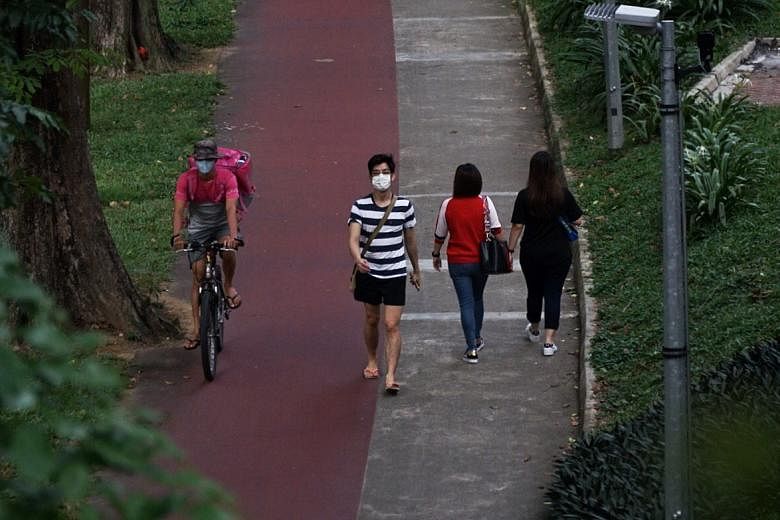SINGAPORE - Pedestrians should stay off shared paths, stick to footpaths if possible and keep to the left unless they are overtaking another pedestrian.
They should also refrain from using their mobile phones while walking on such paths for their own safety.
These points were stated in the first-ever code of conduct here involving pedestrians, which is part of measures first proposed late last year by the Active Mobility Advisory Panel.
The code of conduct for users of public paths had previously focused on device users, such as cyclists and e-scooter riders.
The updated code of conduct kicked in this month, together with a new rule banning those under 16 from riding electric scooters unsupervised by adults. Another new rule bans device users from using their mobile phones while riding.
The Land Transport Authority (LTA) said on Tuesday (Aug 4) that the recommended habits for pedestrians will complement existing active mobility regulations and guidelines for other path users.
"We will continue to engage and educate the public on how all can play a part in fostering a safer and more responsible path-sharing environment," said LTA.
"A campaign encouraging all users to be more gracious on our paths will be rolled out at the end of the year."
The code of conduct recommends these key points for pedestrians: stick to footpaths and pedestrian crossings when available beside shared paths, keep left on all paths, and stay alert when walking on paths.
According to the code, pedestrians should stay alert and pay attention to their surroundings when on a footpath or shared path.
They should also "refrain from using a mobile communication device or operating any of its communication or other functions - such as listening to music - in a manner as will prevent the pedestrian from detecting danger or oncoming obstacles".
The various measures were proposed and introduced in response to a growing number of fires and accidents involving e-scooters last year.
However, such issues have been reduced following a ban on e-scooters on footpaths, among other preventive measures.
National University of Singapore transport infrastructure expert Raymond Ong said the code of conduct involving pedestrians makes sense from both a safety and an infrastructure perspective.
"It makes more sense for pedestrians to keep on their paths for safety reasons... you also want pedestrians to understand that we have a huge role to play in ensuring our own safety," he said.
"We don't have a lot of physical space (to create separations between paths), so it is more about shaping behaviour and trying to make the environment more conducive for walking and cycling."
He said that research has shown that distracted driving, riding and movement leads to an increased risk of accidents and a pedestrian who is not distracted will be better able to avoid them.
Dr Ong added that the lack of mechanisms to enforce the code of conduct is not the issue here but what is important is to educate the public.
"Enforcement is something that is very reactive, but to educate and transform such that these behaviours become more like intuitive-based actions is more important," he said.
But not everyone agrees with the updated code of conduct.
Mr Francis Chu, the co-founder of cycling group Love Cycling SG who previously sat on the AMAP, said it was unnecessary.
"Formalising keeping to the left while walking can cause some aggressive riders to shift the blame to the victim," he said, citing a hypothetical example where in case there is an accident, a device user could blame a pedestrian for not keeping to the left.
Mr Chu said certain pedestrians, such as the elderly and young children, may not be able to keep left and be alert at all times.
He added that the onus should be on cyclists and PMD users to keep their device in control and ensure the safety of pedestrians.
Mr Chu said: "If the main objective is safety for all path users, aren't the two simple rules of riders giving way and keeping a safe distance from pedestrians sufficient?
"It is important to not have a code of conduct for walking and ruin a relaxing walk that elderly pedestrians deserve."
With the banning of underage riding of e-scooters without supervision, the code of conduct for path users has also been updated to include a section for supervisors to refer to.
Adults supervising young riders should keep to one rider at a time and have him or her clearly in their sight.
They should also educate the young rider about safe riding and the relevant regulations.


